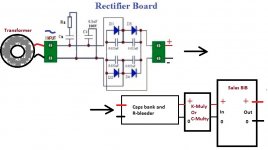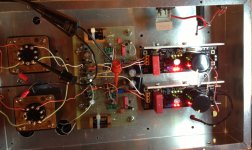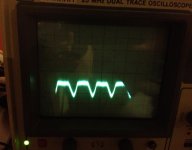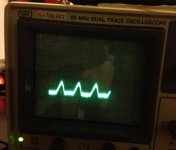It escaped me as a thought. If enough people are finding it nice, by next GB remind me to look into it early enough.
Lets stat a list of "likers".
Let's see how many will sign in. I need your C-Multy PCBs at list 5-6 boards by myself.
If you're going to the trouble, why not add the rectifier diodes, the secondary winding snubbers (C & R-C filters), and a low value series resistor on the 0 volt line to the regulator or another grnd line Cmultiplier/gyrator also (similar to the Coleman reg for DHTs)
Just getting started ...!
Just getting started ...!
If you're going to the trouble, why not add the rectifier diodes, the secondary winding snubbers (C & R-C filters), and a low value series resistor on the 0 volt line to the regulator or another grnd line Cmultiplier/gyrator also (similar to the Coleman reg for DHTs)
Just getting started ...!
It's legitimate concerns and right question if you're fighting with hum in low current circuits. I had tested some of the ways which you did mention in not that-far past in order to kill some hum in very sensitive to V-ripple and EMI/RFI interference devices like Low-V MC Phonos.
a. "why not add the rectifier diodes" -> what do you mean?
b. I do use snubbers technique and I'm calculating Rs and Cs based on Hagerman's guide.
c. CLC is nice, but not cheap and bulky. DC choke with 10+ H and about 200+ mA is weigh 2-3Kg. Size of choke is also big concern...
d. CRC is not efficient enough for "my cases" with "my" MC Phonos.
e. K-Multy worked very-very good to kill my hum.
f. C-Multy was also very good and it is significantly easier to build it.
Attachments
Sorry Alex,
I just meant to add the diodes, snubber, ripple cap to the C-Mx pcb design
I don't use a C-R-C with a following C-Mx but a simpler R-C-R - seems to function better, IMO but not everyone will agree - it's a 'taste thing', I think.
Not a great fan of caps across diodes - not even R-C networks - I tend to use soft recovery diodes rather than the hyper fast ones tho, so maybe that 'taste thing' again
Some years ago I did a valve phono preamp and had some trouble with 'noise' and solved it neatly by adding a C-Mx in the HV supply ground connections in conjunction with the rail reg - this sort of 'thing' was fairly common back then but seems to have disappeared these days
All the best ...
I just meant to add the diodes, snubber, ripple cap to the C-Mx pcb design
I don't use a C-R-C with a following C-Mx but a simpler R-C-R - seems to function better, IMO but not everyone will agree - it's a 'taste thing', I think.
Not a great fan of caps across diodes - not even R-C networks - I tend to use soft recovery diodes rather than the hyper fast ones tho, so maybe that 'taste thing' again
Some years ago I did a valve phono preamp and had some trouble with 'noise' and solved it neatly by adding a C-Mx in the HV supply ground connections in conjunction with the rail reg - this sort of 'thing' was fairly common back then but seems to have disappeared these days
All the best ...
CLC does not need a big choke.................c. CLC is nice, but not cheap and bulky. DC choke with 10+ H and about 200+ mA is weigh 2-3Kg. Size of choke is also big concern...
d. CRC is not efficient enough for "my cases" with "my" MC Phonos.
......................
A few dozen or a hundred turns for an air core is good eneough. The resistance of the wire gives a little bit of r. The resistance of the wiring and secondary of the transformer gives a little bit more r
This changes the CLC to a rCLrC
rCLrC is very effective, does not cost much and does not take up much space.
You can just replace the L with a low value resistor to give a rCrC
the TWO stages of filtering are not quite as effective as the rCLrC but still better than rC that most rely on.
Use your scope to examine the effect of adding turns to the L and the effect of changing little "r".
All of the above works for both low current supplies and high current supplies.
CLC does not need a big choke.
A few dozen or a hundred turns for an air core is good eneough. The resistance of the wire gives a little bit of r. The resistance of the wiring and secondary of the transformer gives a little bit more r
This changes the CLC to a rCLrC
rCLrC is very effective, does not cost much and does not take up much space.
You can just replace the L with a low value resistor to give a rCrC
the TWO stages of filtering are not quite as effective as the rCLrC but still better than rC that most rely on.
Use your scope to examine the effect of adding turns to the L and the effect of changing little "r".
All of the above works for both low current supplies and high current supplies.
I tested 14 AWG 1mH air-core coil in my circuit. I also added step by step 1R resistors. The hum was there on my Phono. No any improvement. Then, I used 12H 68R Choke and it cleaned all my noise completely. My Phono was dead-quite with it, but size...... So, in theory all your points are probably right, beside for high current fast devices like Class A amps when you can create sag effect during "crishendo" moments. My practice proofed that C-Multy and K-Multy is the most elegant and size-wise minimalistic solution. They both cleaned all hums perfectly and I think we should include one of these into Raw DC board PCB.
that's a big jump from 1mH to 12H.
A two stage rCLrCrC filter would probably manage to attenuate your hum below audibility.
But your chosen route has done that anyway so stick with it.
I'd prefer if you did not put down perfectly workable alternatives without proper experimentation.
A two stage rCLrCrC filter would probably manage to attenuate your hum below audibility.
But your chosen route has done that anyway so stick with it.
I'd prefer if you did not put down perfectly workable alternatives without proper experimentation.
I agree. I do not have my stock with some X2, X3 or even X10 that I can test with. I got 1mA and 12H, and nothing in-between....
This is why I advised to the rest of guys who has similar situation with limited parts stock to use something that has been tested with 100% built proof results.
For high power A class amps which requires high and fast current, Nelson Pass advised not to use any coils in PSUs since it might slow down necessary current delivery and might create an issue with oscillations. He advised CRC only. Cheap and quite good.
This is why I advised to the rest of guys who has similar situation with limited parts stock to use something that has been tested with 100% built proof results.
For high power A class amps which requires high and fast current, Nelson Pass advised not to use any coils in PSUs since it might slow down necessary current delivery and might create an issue with oscillations. He advised CRC only. Cheap and quite good.
A further consideration Alex, is the use of Fet or transistor as the active device, both for low and high current use (ie the K-Mx is great for low current but does require a specific range of devices whereas the C-Mx doesn't have the 'gain' but is more tolerant of devices and power - (not news, I know!)
Also, there's quite a difference in the sound of high drop out fets like the IRFP240s (Vds about 4.5V) and the low drop out devices (less than 0.5V) - probably similar effect with transistors - the cap choice is still the major consideration tho, and the extra (double) filtering of the base/gate connection, IMO.
An interesting thing - I tried one of Teddy Pardu's Super Teddy (C-Mx section only using the Sizkai (?) cct before the basic Salas shunt and preferred the sound of the basic C-Mx - had an added 'edge' or brightness to the sound that was undesirable for the DAO headamp running about 250mA - must get back to trying the K-Mx one day ...
Also, there's quite a difference in the sound of high drop out fets like the IRFP240s (Vds about 4.5V) and the low drop out devices (less than 0.5V) - probably similar effect with transistors - the cap choice is still the major consideration tho, and the extra (double) filtering of the base/gate connection, IMO.
An interesting thing - I tried one of Teddy Pardu's Super Teddy (C-Mx section only using the Sizkai (?) cct before the basic Salas shunt and preferred the sound of the basic C-Mx - had an added 'edge' or brightness to the sound that was undesirable for the DAO headamp running about 250mA - must get back to trying the K-Mx one day ...
Phono PS Hum
I built a phono preamp using Salas Shunt power supplies. It is still in the prototype testing phase using chassis from previous projects so you will see parts not being used. Attached are Oscope pictures of residual low frequency noise/hum for the left and right power supplies measured at the attachment points to the phono board. The 200ma Salas power supplies are set at 26vdc and send about 50ma to each side of the phono preamp. The Oscope is set at 1mv/div at 20ms. There is no 60/120 Hz noise shown of the scope coming from the step-up transformers.
There is audible hum from the phono preamp. Here are the possibilities I can think of:
1. Problem with my Salas shunts.
2. A different kind of power supply is more suitable for ultra low noise to phono circuits.
3. Filter/smoothing caps should be installed after each Salas shunt.
4. Add a Bybee Music Rail after the Salas to reduce noise.
Any suggestions?
I built a phono preamp using Salas Shunt power supplies. It is still in the prototype testing phase using chassis from previous projects so you will see parts not being used. Attached are Oscope pictures of residual low frequency noise/hum for the left and right power supplies measured at the attachment points to the phono board. The 200ma Salas power supplies are set at 26vdc and send about 50ma to each side of the phono preamp. The Oscope is set at 1mv/div at 20ms. There is no 60/120 Hz noise shown of the scope coming from the step-up transformers.
There is audible hum from the phono preamp. Here are the possibilities I can think of:
1. Problem with my Salas shunts.
2. A different kind of power supply is more suitable for ultra low noise to phono circuits.
3. Filter/smoothing caps should be installed after each Salas shunt.
4. Add a Bybee Music Rail after the Salas to reduce noise.
Any suggestions?
Attachments
Last edited:
Disconnect the active circuit as load and use a dummy load for 50mA instead. Can you still see ripple across the dummy resistor? If not, then the supplies are OK. As general precautions you need to have >5V DC in-out across the supplies, no ground loops in the circuits, and twisted or shielded pairs from supply to load.
P.S. Are there only three output wires used instead of four? It takes all four to be utilized.
P.S. Are there only three output wires used instead of four? It takes all four to be utilized.
rCLrC also has a damping resistance in there................He advised CRC only. ..............
r is automatically included in an air core coil.
Slow Transients are fed from the last C, not from the first C.
Whether it is R, or Lr, as the filter component makes no difference to the supply of current for fast transient demands.
The fast & fastest transients get their current from the local decoupling.
Last edited:
post2913
is that regulator drop out showing at the feed in point to the amplifier?
What is the repetition rate of the glitches?
is that regulator drop out showing at the feed in point to the amplifier?
What is the scope timebase setting?power supplies measured at the attachment points to the phono board.
What is the repetition rate of the glitches?
20mS he wrote. So its 32mS in period roughly on the screen. About 30Hz. And it does not have the zigzag shape that bridge and capacitor only rectification ripple has. It suspiciously misses a sense 0 connection for each output connector which is only three points type as far as I can tell from the build's picture.
If it is not regulator drop out, then what is causing the glitches?
If the timebase is in error then that estimated 30Hz could be 100Hz, or 120Hz (if a bridge rectifier is used).
The drop out does not mimic the shape of the unregulated ripple on the smoothing capacitors.
We only get to see a bit of the supply droop when the regulator actually stops regulating.
The other part of the ripple gets hidden by the regulator action, when sufficient Vdrop is available.
If the timebase is in error then that estimated 30Hz could be 100Hz, or 120Hz (if a bridge rectifier is used).
The drop out does not mimic the shape of the unregulated ripple on the smoothing capacitors.
We only get to see a bit of the supply droop when the regulator actually stops regulating.
The other part of the ripple gets hidden by the regulator action, when sufficient Vdrop is available.
Phono Hum Fixed
First I want to respond to points made to my original post on this issue. The rectified voltage is about 36vdc giving a 10 volt drop across the Salas shunt. The Oscope sweep setting was 10ms, not 20ms making the hum 60 Hz.
I noticed that the left and right Oscope patterns were complementary, that is, they would combine to produce a flat line. I switched to a single Salas shunt running at 250ma feeding both channels of the phono board. The Oscope display at the connection point on the board was a flat line - problem solved! For reasons I can't explain the pair of Salas shunts evidently were fighting each other by having the ground signals connected on the phono board. The phono preamp sounds great too.
Thanks to all for forum help on this issue.
First I want to respond to points made to my original post on this issue. The rectified voltage is about 36vdc giving a 10 volt drop across the Salas shunt. The Oscope sweep setting was 10ms, not 20ms making the hum 60 Hz.
I noticed that the left and right Oscope patterns were complementary, that is, they would combine to produce a flat line. I switched to a single Salas shunt running at 250ma feeding both channels of the phono board. The Oscope display at the connection point on the board was a flat line - problem solved! For reasons I can't explain the pair of Salas shunts evidently were fighting each other by having the ground signals connected on the phono board. The phono preamp sounds great too.
Thanks to all for forum help on this issue.
- Home
- Amplifiers
- Power Supplies
- SSLV1.1 builds & fairy tales



